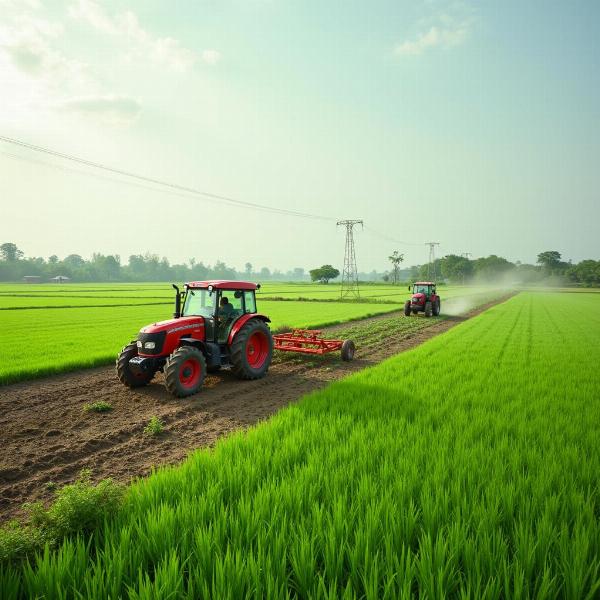Krushi, a word deeply rooted in Hindi and Indian culture, signifies agriculture. Understanding its meaning goes beyond a simple translation; it encompasses a way of life, a source of sustenance, and a cornerstone of the Indian economy. This article explores the multifaceted meaning of krushi, its cultural significance, and its impact on India’s past, present, and future.
Understanding the Core Meaning of Krushi
Krushi (कृषि) in Hindi directly translates to agriculture or farming. It encompasses all activities related to cultivating land, raising crops, and rearing livestock. For centuries, krushi has been more than just an occupation in India; it’s a way of life, a tradition passed down through generations. Many Indians have an inherent connection to the land, viewing it as a sacred entity providing sustenance and prosperity.
What does krushi mean to the average Indian? It represents their livelihood, their connection to their ancestors, and their hope for the future. It is the foundation of the nation’s food security and a vital contributor to the economy.
The Cultural Significance of Krushi in India
Krushi is deeply interwoven with Indian culture and traditions. Numerous festivals and rituals revolve around the agricultural cycle, celebrating harvests and invoking blessings for future crops. These celebrations reflect the profound respect Indians hold for nature and its bounty. Festivals like Makar Sankranti, Pongal, and Baisakhi are prime examples of this cultural connection. They highlight the importance of krushi in the social fabric of the country.
From ancient scriptures to folk songs, krushi is a recurring theme, illustrating its central role in Indian society. These cultural expressions not only depict the practical aspects of farming but also the emotional and spiritual connection people have with the land.
Krushi and the Indian Economy
Krushi remains a significant contributor to the Indian economy, employing a large portion of the population and playing a crucial role in food production. The agricultural sector faces numerous challenges, including climate change, water scarcity, and market fluctuations. However, the government and various organizations are working towards modernizing krushi practices, promoting sustainable agriculture, and empowering farmers.
 Modern Farming Techniques in India
Modern Farming Techniques in India
The Future of Krushi
The future of krushi in India hinges on embracing sustainable practices, technological advancements, and empowering farmers. Initiatives promoting organic farming, water conservation, and improved market access are vital for ensuring food security and economic growth. The integration of technology in krushi, such as precision farming and data analytics, holds immense potential for optimizing yields and improving resource management.
How can we ensure a thriving future for krushi? By investing in research and development, providing farmers with the necessary resources and training, and fostering a supportive policy environment. The future of krushi is intrinsically linked to the future of India, and its continued development is crucial for the nation’s prosperity.
What are the different types of Krushi practiced in India?
India’s diverse climate and geography support a wide range of agricultural practices. From subsistence farming in remote villages to large-scale commercial agriculture, krushi takes on many forms. These include irrigated farming, rain-fed farming, organic farming, and integrated farming systems.
Conclusion
Krushi, meaning agriculture in Hindi, is more than just a word; it’s a cornerstone of Indian culture, economy, and way of life. Its significance goes far beyond the simple act of farming, encompassing deep-rooted traditions, spiritual beliefs, and economic realities. Understanding krushi is essential for comprehending the fabric of Indian society and its future.
FAQ
- What is the literal meaning of Krushi? Krushi literally means agriculture or farming.
- Why is Krushi important for India? Krushi is crucial for India’s food security, economic stability, and cultural heritage.
- What are some challenges faced by Krushi in India? Challenges include climate change, water scarcity, and market volatility.
- How can we improve Krushi in India? By promoting sustainable practices, investing in technology, and empowering farmers.
- What is the future of Krushi in India? The future depends on embracing innovation, sustainability, and farmer-centric approaches.
- What are some common crops grown in India through Krushi? Rice, wheat, sugarcane, cotton, and pulses are some common crops.
- What is the role of technology in modern Krushi? Technology can optimize yields, improve resource management, and connect farmers to markets.
Meaning-Hindi.in is your trusted partner for professional Hindi translation services. We specialize in a wide range of translation solutions, including business and commercial documents, legal and certified translations, technical manuals, website localization, educational materials, and specialized industry translations. Our team of expert linguists ensures accurate and culturally sensitive translations, catering to diverse client needs. Need help with your translation project? Contact us today at [email protected] or call us at +91 11-4502-7584. Meaning-Hindi.in is committed to delivering high-quality language solutions that bridge communication gaps and empower global connections.